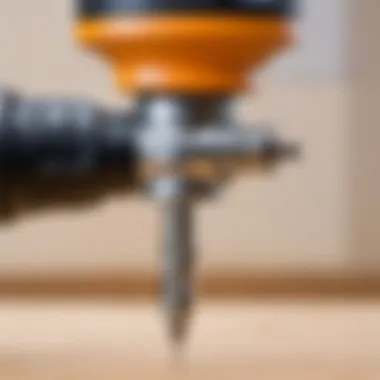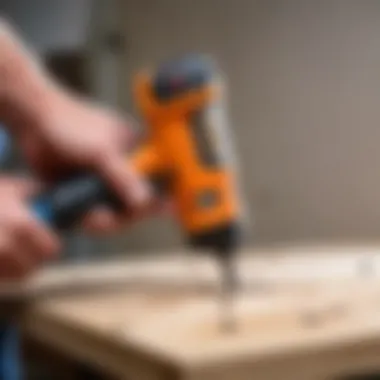How to Safely Extract a Stuck Electric Screwdriver Bit


Intro
Electric screwdrivers are highly efficient tools for various DIY projects and home repairs. However, issues arise when the screwdriver bit becomes stuck. Such situations not only cause frustration but can also hinder progress on significant tasks. This article will delve into effective methods for extracting a jammed bit from an electric screwdriver.
Understanding the common causes behind a stuck bit can help mitigate the risk of similar problems in the future. Additionally, we will cover necessary precautions, recommended tools, and strategies to minimize inconvenience.
Though extracting a stuck bit may seem daunting, with the appropriate guidance and techniques, you can resolve this issue effectively. Prepare to enhance your DIY skills and keep your electric screwdriver in top shape for your next project.
Проектирование и планирование
Как выбрать проект для DIY
Selecting the right DIY project is essential for ensuring a smooth and enjoyable experience with your electric screwdriver. Consider starting with smaller tasks that require minimal intricacies. Projects, such as assembling furniture or repairing fixtures, often offer practical opportunities to hone your skills and become familiar with tool handling. This way, if a screw ever becomes lodged, you will be better prepared to address it.
Оценка времени и ресурсов
Time is an important factor in any DIY project. Assess the estimated time you can devote to the task, along with the availability of tools and materials. If your electric screwdriver is crucial in executing the project, ensure it is ready for use. Also, consider buying an additional bit or two, which can prevent delays if issues arise during installation or disassembly.
Common Causes of Sticking Bits
A stuck bit usually results from one of several reasons. Understanding these causes can lead to effective prevention strategies.
- Excessive force: Applying too much strength while driving screws can expand the bit's grip, making it difficult to remove.
- Dirt and debris: Dust accumulation in the tool's chuck can hinder smooth operation, leading to bits becoming lodged.
- Wear and tear: Over time, bits wear down. If the fit becomes too tight, it can cause jamming.
Proper care and regular maintenance of your electric screwdriver can greatly reduce the risk of bit jamming.
Recommended Tools and Techniques
To successfully extract a stuck bit, consider the following tools and techniques:
- Pliers: Use pliers to grasp the stuck bit firmly and twist gently to dislodge it.
- Lubrication: A high-quality lubricant can aid in loosening a stuck bit. Apply it cautiously around the chuck area and wait a few minutes for it to take effect.
- Rubber band: If the bit is stuck due to wear, place a rubber band over the bit for extra grip when trying to twist.
These methods can be applied in various combinations depending on the severity of the jammed bit.
Prevention Strategies
To avoid future occurrences of stuck bits, implement the following strategies:
- Regularly clean your tool: Ensure that dirt and dust do not accumulate in the chuck of your electric screwdriver.
- Use the right bit size: Using bits that match the screw size will minimize the chance of over-tightening and jamming.
- Store tools correctly: Keep your electric screwdriver in a protective case when not in use to shield it from impacts and debris.
Adopting these practices can prolong the life of your tools and improve overall efficiency in your projects.
Ending
By mastering these methods, you can approach your projects with confidence, knowing you have the skills to address and prevent common issues.
Prelims to the Issue of Stuck Bits
A stuck bit in an electric screwdriver is a frustrating problem. For many, the electric screwdriver is an essential tool in both professional and home repair settings. When the bit becomes jammed, it can halt progress and complicate tasks. Understanding the reasons behind this issue and how to effectively address it is crucial.


The cause of a stuck bit can range from mechanical mishaps to improper handling. Identifying these factors can lead to faster solutions and an overall improved experience using the tool. Alongside practical removal techniques, knowledge of preventive measures will be beneficial to keep the reliability of the screwdriver intact.
What is at stake here is not just the tool itself but also the efficiency of the tasks at hand. A deep dive into the intricacies of electric screwdrivers and the mechanics involved can offer insights that empower users in a significant way.
Safety Precautions Before Attempting Removal
When faced with the problem of a stuck bit in an electric screwdriver, safety should always be the priority. Before attempting any removal methods, taking certain precautions ensures not only your safety but also the integrity of the tool. Engaging in mechanical work carries inherent risks, especially when dealing with electrical devices. Proper precautions can prevent injuries and damage to the screwdriver.
Understanding and implementing these safety measures significantly benefits anyone tackling this task. Firstly, ensuring that the tool is completely powered down and disarmed reduces the risk of accidental activation. Secondly, wearing protective gear ensures that you are safeguarded against flying debris or acute injuries during physical extraction attempts.
Therefore, let’s explore the critical aspects of safety that should not be overlooked before proceeding with the extraction process.
Unplugging and Discharging the Tool
Unplugging the electric screwdriver is the first and most essential step. Disconnecting the device from its power source eliminates the risk of accidental engagement. This act is not merely a precaution; it is a fundamental practice in safe tool handling. Once unplugged, it is wise to ensure the tool's capacitors are discharged. To accomplish this, one can press the trigger several times. This action allows any remaining charge to release and protects against unexpected movements during the extraction of the stuck bit.
Failing to follow this step may result in serious injuries or damage. An energized screwdriver can easily lead to various hazards, including electrical shocks or unintentional injuries from moving parts. Thus, always remember: disconnecting and discharging the tool is a mandatory action in your preparation to extract a stuck bit.
Wearing Appropriate Protective Gear
Investing in personal protective equipment (PPE) is crucial when working with tools. Even if it seems unnecessary, wearing items such as safety goggles, gloves, and a dust mask can make a significant difference. Safety goggles protect your eyes against debris or fragments that may dislodge during efforts to remove the stuck bit. Gloves not only offer grip but also shield your hands from potential sharp edges or undesired scrapes. A dust mask can prevent inhalation of particles that may arise during the mechanical extraction process.
Additionally, ensure that your clothing is not loose. Free-hanging garments can easily get caught in moving parts, resulting in unnecessary accidents. In a workshop or home repair scene, a few moments spent on preparation can spare you from considerable setbacks later on.
Taking the time to prioritize safety can save you from injuries and property damage. Always go through the safety checklist before starting any repair work.
In summary, prioritizing safety while attempting to extract a stuck bit from an electric screwdriver cannot be emphasized enough. Proper action items include unplugging, discharging the tool, and utilizing appropriate protective gear, all of which streamline your repair process while ensuring personal safety.
Common Scenarios Leading to Stuck Bits
Understanding the various scenarios that can lead to stuck bits is crucial for anyone using an electric screwdriver. Being familiar with these situations helps you to identify and prevent issues before they escalate. Recognizing potential problems enables proactive measures, saving time and frustration. It’s also beneficial to troubleshoot effectively when issues arise, ensuring that you can address stuck bits with efficiency.
Over-tightening of Fasteners
One common reason for a stuck bit is over-tightening of fasteners. This occurs when screws or bolts are turned too tightly, causing them to become jammed in the material they secure. Often, this happens when users apply excessive force, believing it will enhance the holding power. Unfortunately, this can lead to deformation of the screw head or the bit itself, locking the bit in place. To avoid this scenario, it’s essential to use proper torque settings as specified in the tool’s manual. Always ensure that the screwdriver is set to the right speed and torque level for the task at hand. As a rule of thumb, stop tightening once you feel resistance.
Incompatibility of Bit and Tool
Another significant factor is the incompatibility of the bit and the electric screwdriver. Not all bits fit every screwdriver. Using a bit that does not match the chuck size or style can lead to binding. This mismatch often happens when bits from different manufacturers are mixed or when older bits are used with newer tools. Checking compatibility is vital to ensure smooth operation. Most electric screwdrivers have specifications for the bits they support. Before starting any work, verify that your selected bit is compatible with the tool to reduce the risk of it becoming stuck.
Wear and Tear Factors
Finally, wear and tear factors cannot be overlooked. Over time, bits naturally dull or wear down, which impacts their performance. A worn bit may struggle to grip fasteners correctly, increasing the chances of slipping or jamming. Regular inspection of your bits can help identify worn ones before they become problematic. If you notice any signs of wear, such as chipping or a lack of sharp edges, it is good to replace the bit. This small action can prevent future stuck bits and maintain the overall effectiveness of your electric screwdriver. Regular maintenance and timely replacements can ensure that your tools remain in optimal condition.
Methods for Extracting a Stuck Bit
Manual Extraction Techniques
Manual extraction techniques can be the simplest way to remove a stuck bit, especially if it’s only mildly jammed. This might involve simply tugging or twisting the bit while holding the screwdriver steady. For some electric screwdrivers, especially those designed for ease of use, this can work without additional tools. However, caution is necessary to avoid damage to the bit or the drive mechanism. Using force can backfire, causing more significant issues. Always check the direction of rotation and ensure the tool is off to avoid accidents.


Using Pliers for Grip
When the bit is stuck firmly, using pliers can provide the extra leverage needed to free it. Ensure that the pliers have a good grip on the bit without slipping. Apply steady pressure, but avoid jerky movements which can damage the screwdriver or the bit. This method is particularly useful for hex bits or standard screw heads, where the pliers can directly grip the part. Ensure that your pliers are clean to avoid scratching the bit. The technique can be effective but requires patience and careful handling.
Applying Lubricants
Lubrication can ease the extraction process, especially if rust or debris is involved. A light spray of penetrating oil can be very effective. Spray it generously at the junction of the bit and the screwdriver, allowing it to seep in. Wait for a few minutes to enable the lubricant to work. This approach allows the bit to slide out more easily when gentle force is applied. Avoid using excessive amounts of oil, which can lead to messy situations and potentially affect other components of the screwdriver.
Heat Application Approaches
For stuck bits that resist all other methods, heat can serve as a last resort. Applying heat can expand metal components, loosening stubborn bits. Use a heat gun or a soldering iron for this method. Be cautious about overheating, which can warp or damage the screwdriver. Apply heat directly onto the bit without exposing the tooling to excessive temperatures. After allowing it to cool slightly, try extraction again. This method should be employed only when other methods have failed and there’s a risk of causing damage during extraction.
Utilizing Extractor Tools
Extractor tools are specifically designed for situations like these, where other methods have not succeeded. They come in various forms, such as screw extractors or specialized bit removers. Utilizing these tools can be very effective, but it requires some knowledge about their use. Always follow the manufacturer's instructions for best results. Ensure you choose an extractor that fits the size and shape of the bit and use it with care. While this method might be more advanced, it is one of the most effective if you find yourself struggling.
The right method combined with proper preparation can make a significant difference in successfully removing a stuck bit.
When selecting a method, consider factors like the type of bit, the screwdriver’s condition, and the tools you have at your disposal. Each approach has its nuances, and understanding them will help in making the right choice for effective removal.
Tools Required for Bit Removal
Essential Hand Tools
Hand tools are indispensable for anyone tackling the challenge of a stuck bit. Some of the most essential hand tools include:
- Screwdriver Set: Use these to manually assist in turning the bit if it is partially unscrewed. Select the right head type, such as Phillips or flat-head, depending on the screwdriver and bit compatibility.
- Wrench: In cases where the bit is really stuck, having a small adjustable wrench can provide added torque. Ensure a tight fit around the bit without slipping.
- Pliers: Needle-nose or locking pliers can be particularly useful for gripping bits that are embedded deep inside the screwdriver. This allows for a better grasp without causing damage to the surrounding area.
- Hammer: A small hammer can sometimes help. Gently tapping the bit may dislodge it by breaking whatever holds it in place. Do this with caution to avoid damaging the screwdriver.
Using these hand tools properly can expedite the removal process. It's not just about having the tools; using them correctly is equally important.
Power Tools and Their Applications
While hand tools are vital, some power tools can also assist in removing stuck bits when used with care. Here are a few examples:
- Cordless Drill: If the bit is jammed but has some movement, a cordless drill can be employed in reverse to loosen the grip. Be sure to apply low speed to prevent stripping the bit.
- Impact Driver: An impact driver delivers quick bursts of force, which are effective for breaking loose a stubborn bit. It is particularly advantageous because of the combination of torque and speed.
- Dremel Tool: In more extreme cases, a Dremel tool can be used to grind down the bit if it proves to be irretrievable. While this may destroy the bit, it provides a last resort method to free components.
Remember to always use protective eyewear when operating power tools, ensuring safety during the bit removal process.
Selecting the right power tool with matching applications is imperative for successfully executing the task at hand. Having a well-organized toolkit ready makes the whole process smoother.
Preventive Strategies for Future Incidents
Preventive strategies are crucial when dealing with electric screwdrivers, particularly in avoiding the common problem of stuck bits. By implementing proactive measures, users can minimize the risk of encountering a jammed bit in the first place. This section, therefore, focuses on several practical tips that can lead to more effective usage and care of the tool. The key is to develop consistent habits that encompass both maintenance and the proper handling of bits.
Routine Maintenance of Tools
Maintenance should not be considered an afterthought. For electric screwdrivers, regular upkeep includes ensuring that all moving parts are clean and free of debris. Dust and clear residue can accumulate over time, potentially leading to bit engagement issues. To maintain your tool effectively, it is advisable to:
- Clean the chuck regularly to remove debris or old lubricants.
- Check battery performance and connections to ensure optimal power delivery.
- Perform a simple visual inspection before each use to identify any wear or malfunction.


These practices will prolong for the tool's life and reduce the likelihood of bits becoming stuck.
Selecting the Right Bit
Selecting the proper bit is essential for avoiding issues with electric screwdrivers. Using an incompatible bit not only increases the chances of it being stuck but also can damage the fastener or tool. It is vital to:
- Refer to the manufacturer's specifications to choose the correct size and type of bit.
- Utilize high-quality bits that fit snugly in the chuck. Cheap replicas or mismatched sizes often lead to problems.
- Experiment with different materials or coatings if you experience frequent bit wear or sticking.
Such careful consideration will greatly enhance performance and reduce incidents of stuck bits.
Adhering to Manufacturer Guidance
Every electric screwdriver comes with specific instructions from the manufacturer. This guidance often includes proper usage techniques, recommended accessories, and maintenance schedules. Users should follow these guidelines closely as they are tailored for each tool. Adhering to manufacturer instructions involves:
- Reading the user manual thoroughly, paying attention to recommended practices.
- Utilizing recommended lubricants and maintenance products designed for the tool.
- Being attentive to updates or revisions provided by the manufacturer regarding care and safety.
By sticking to these recommendations, users create a foundation for best practices, minimizing issues like bit jamming.
Regularly reviewing and adhering to the manufacturer's guidelines can significantly prevent tool-related incidents and enhance longevity.
When to Seek Professional Help
Attempting to extract a stuck bit from an electric screwdriver can seem straightforward, yet various factors can complicate the process. The decision of whether to tackle this issue independently or enlist professional assistance is crucial. Understanding when to seek help can prevent unnecessary damage to your tool and ensure your safety. This section discusses important considerations that underline the value of professional intervention.
Recognizing the Limits of DIY
While many DIY enthusiasts take pride in their ability to repair or troubleshoot tools, some situations warrant caution. Recognizing when to stop tinkering is essential. If the bit is firmly lodged and initial recovery attempts using basic methods—like manual pulling or applying lubricants—fail, pushing further might lead to damage. Overzealous attempts could strip the bit or even harm the screwdriver’s internal mechanisms. More than that, when trying to extract a bit involves high levels of force or intricate tools, the risk of accidents or injuries increases.
It is important to ask yourself:
- Have you tried multiple methods without success?
- Is there a chance that continuing might injure you or damage the tool?
- Are you feeling frustrated or confused about the next steps?
If any of these resonate with your experience, it may be wise to consult a professional technician. They possess the expertise and specialized tools to handle stubborn bits without inflicting further harm.
Finding a Qualified Technician
When it becomes clear that your efforts at home might not yield the best outcome, finding a qualified technician is the next step. It's not only about locating someone to help; it involves finding an expert capable of effectively diagnosing and solving the issue. A professional with ample experience can often extract the bit in a matter of minutes, saving you time and avoiding potential damage.
Consider these factors when choosing a technician:
- Experience: Look for technicians with a solid track record in tool repairs, particularly those familiar with electric screwdrivers.
- Reviews: Checking online platforms for feedback can help gauge the quality of their work. Websites like Reddit or even Facebook can have valuable discussions and recommendations.
- Certifications: Credentials and certifications signal a technician's proficiency and commitment to quality service.
- Cost Estimates: Obtaining a rough cost estimate up front can clarify the financial aspect and help you decide based on your budget.
Above all, remember that in some cases, avoiding a do-it-yourself attitude can lead to more cost-effective and safer results in maintaining your tools. Engaging a professional might seem like an additional expense, but it can ultimately enhance the lifespan of your equipment and your peace of mind.
Epilogue
The conclusion of this article serves as a pivotal recapitulation of the complexities surrounding the extraction of a stuck bit from an electric screwdriver. It emphasizes the relevant techniques, tools, and preventive measures necessary for both DIY enthusiasts and professionals in the construction and repair industries. By summarizing the bit removal process, readers can clearly understand the practical steps to resolve this common inconvenience.
Summing Up the Bit Removal Process
In essence, removing a stuck bit involves several key approaches. The first step typically includes assessing the situation to identify the right method for extraction. Techniques such as using manual controls or employing tools like pliers may be effective. Should these methods prove insufficient, the application of lubricants or, in more stubborn cases, the introduction of heat can provide the force needed to dislodge the bit. Paying close attention to the specific type of screw and screwdriver is fundamental, as incompatible pieces can exacerbate the issue. Moreover, utilizing specialized extractor tools designed for this purpose can save considerable time and effort.
Final Thoughts on Maintenance and Care
Proper maintenance is crucial in preventing future occurrences of stuck bits. Regularly inspecting the electric screwdriver for signs of wear and ensuring compatibility between bits and the tool can significantly increase performance. Following the manufacturer's guidance and engaging in routine maintenance checks lays a solid foundation for the longevity of the tool. Ultimately, approaching the care of tools with diligence not only fosters efficiency but also enhances safety during operations. The importance of these considerations cannot be understated, as they reflect a proactive attitude towards tool management and preservation.







